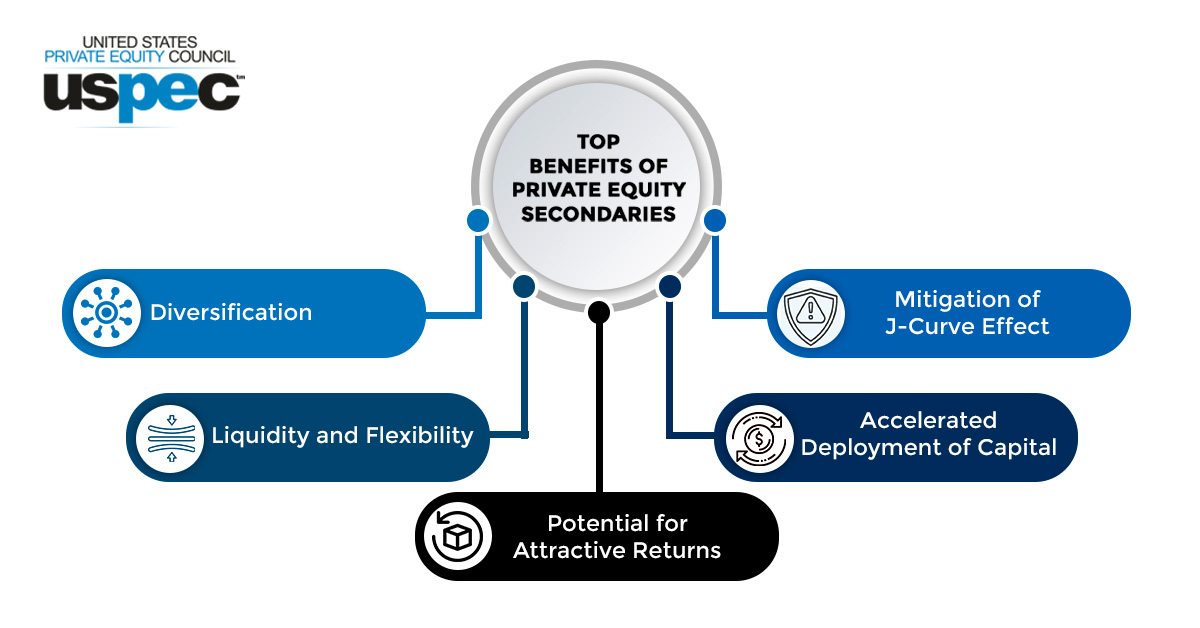In the ever-evolving landscape of the private equity industry, a distinct investment strategy has gained prominence in recent years: private equity secondaries. This article will take you on a journey through the history, benefits, and future growth potential of private equity secondaries, offering valuable insights into this exciting investment avenue.
What Are Private Equity Secondaries?
Private equity secondaries refer to the buying and selling of pre-existing investments in funds or portfolios. These investments can range from limited partnership interests in funds to direct investments in companies. Essentially, secondaries allow investors to enter or exit investments without the need to participate in the primary fundraising process.
A Brief History of Private Equity Secondaries:
To fully appreciate the significance of secondaries in the investment landscape, it is essential to delve into their intriguing history. The roots of secondaries can be traced back to the early days of the private equity industry, which experienced rapid growth and transformation in the 1980s and 1990s.
During this period, private equity investments gained traction as a viable alternative asset class, attracting increased interest from institutional investors, pension funds, and high-net-worth individuals. As the industry matured, limited partners (LPs) began to realize the potential benefits of actively managing their portfolios and seeking liquidity options before the typical fund life cycle ended.
It was against this backdrop that the concept of secondaries emerged. LPs, eager to achieve liquidity and optimize their portfolios, sought avenues to exit their investments earlier than anticipated. This demand for liquidity gave rise to a nascent secondary market where LPs could sell their existing ownership interests to interested buyers.
Initially, the secondary market was relatively small and operated informally through private negotiations and relationships among LPs. However, as the industry continued to grow and evolve, the secondary market expanded in tandem, driven by the increasing recognition of its value and the demand for greater flexibility among investors.
In the late 1990s and early 2000s, dedicated secondary market participants, known as secondary buyers or secondary funds, emerged. These specialized firms recognized the untapped potential of secondaries and actively sought opportunities to acquire interests in funds at discounted prices. As the secondary market gained momentum, it attracted a broader range of buyers, including institutional investors, family offices, and even some primary fund managers.
The global financial crisis of 2008 had a profound impact on the industry, including the secondary market. The crisis created a surge in demand for liquidity among LPs, prompting them to actively manage their portfolios and seek exit options for their investments. This led to an increase in secondary market activity as buyers saw an opportunity to acquire quality assets at more favorable valuations.
In the years that followed, the secondary market continued to flourish, driven by several factors. Institutionalization of the industry, the growth of mega-funds, regulatory changes, and the increasing awareness and acceptance of private equity as a mainstream investment asset class all contributed to the expansion of the secondary market.
Today, secondaries have become an integral part of the private equity ecosystem, offering investors a valuable avenue to achieve liquidity, optimize portfolios, and access attractive investment opportunities. The secondary market has evolved into a vibrant and dynamic space, characterized by increased transparency, standardization of processes, and a diverse range of participants.
As the investment landscape continues to evolve, the history of secondaries serves as a testament to the resilience and adaptability of the industry. The secondary market has not only provided liquidity solutions but has also played a pivotal role in driving innovation and growth within the industry.
Why Consider Private Equity Secondaries?
Environmental Factors
- Portfolio Diversification: Secondaries provide an opportunity to diversify investment portfolios by gaining exposure to a broad range of assets across different vintage years, sectors, and geographies.
- Liquidity: Unlike primary investments, which are often illiquid and subject to lengthy lock-up periods, secondaries offer investors the possibility of accessing liquidity and adjusting their portfolios according to their evolving investment strategies and needs.
- Pricing Efficiency: The secondary market allows investors to purchase assets at a discount or premium to their net asset value (NAV), providing potential opportunities to generate attractive risk-adjusted returns.
- Time Efficiency: By investing in secondaries, investors can potentially accelerate the deployment of capital compared to primary fund investments, as the assets are already established and in operation.
These advantages make secondaries an appealing investment option, allowing investors to diversify their portfolios, access liquidity, and potentially capitalize on pricing inefficiencies. By considering secondaries, investors can optimize their investment strategies and navigate the investment landscape with greater flexibility and efficiency.
What Are the Different Types of Secondaries?
Private equity secondaries can take various forms, depending on the type of transaction and the nature of the assets involved:
- Direct Secondaries: Direct secondaries involve the purchase of direct investments in companies from existing investors, providing an avenue for investors to acquire exposure to specific companies or industries.
- LP Interest Transfers: LP interest transfers involve the buying and selling of limited partnership interests in private equity funds. Investors can acquire stakes in funds at various stages of their life cycle.
- GP-led Secondaries: GP-led secondaries involve transactions led by the general partner of a private equity fund. These transactions can include fund restructurings, recapitalizations, or the sale of portfolio assets to another fund.
- Secondary Fund Investments: Secondary fund investments refer to investments in dedicated secondary funds managed by specialized secondary market investors. These funds offer diversified exposure to a broad range of private equity assets.
The Top Benefits of Private Equity Secondaries
Private equity secondaries offer a host of advantages that make them an appealing investment option for a wide range of investors:
-
Diversification:
Secondaries provide the opportunity to diversify investment portfolios by gaining exposure to a range of assets across different industries, geographies, and vintage years.
-
Liquidity and Flexibility:
Investing in secondaries offers greater liquidity compared to primary investments. Investors can access liquidity by selling their existing holdings or adjusting their portfolios according to their changing investment strategies.
-
Potential for Attractive Returns:
Secondaries have the potential to generate compelling risk-adjusted returns. By acquiring assets at a discount to their NAV or taking advantage of market inefficiencies, investors can aim to achieve attractive financial outcomes.
-
Accelerated Deployment of Capital:
Secondaries enable investors to deploy capital more rapidly compared to primary investments, as the assets are already in operation and generating cash flows.
-
Mitigation of J-Curve Effect:
The J-curve effect, characterized by negative cash flows in the early years of investments, can be mitigated through investing in secondaries. By entering at a later stage of a fund's life cycle, investors can potentially avoid the initial negative cash flow period.

These benefits collectively make private equity secondaries an enticing proposition for investors looking to diversify their portfolios, enhance liquidity, and capitalize on attractive investment opportunities. By taking advantage of the unique characteristics of secondaries, investors can navigate the investment landscape with greater flexibility and potentially achieve favorable risk-adjusted returns.
The Growth Drivers of Private Equity Secondaries
The private equity secondaries market has experienced significant growth in recent years, driven by several key factors:
-
Market Sophistication:
The private equity industry has evolved, and market participants have become more knowledgeable and sophisticated in understanding the value and opportunities offered by private equity secondaries.
-
Increasing Investor Demand:
Investors are increasingly recognizing the benefits of private equity secondaries in their investment strategies. Institutional investors, family offices, and high-net-worth individuals are actively seeking exposure to private equity secondaries as a means of portfolio diversification and enhancing risk-adjusted returns.
-
Growing Supply of Assets:
The supply of private equity assets available in the secondary market has increased due to factors such as fund restructurings, portfolio realignments, and the desire for liquidity among investors.
-
Maturing Private Equity Industry: As the private equity industry continues to mature, limited partners are seeking opportunities to actively manage their portfolios, strategically exit underperforming investments, and recycle capital into more promising opportunities.
Conclusion
Private equity secondaries have emerged as a dynamic and attractive investment avenue within the private equity industry. Offering diversification, liquidity, and potential for attractive returns, private equity secondaries have gained traction among investors seeking to optimize their portfolios. With a growing market and evolving opportunities, the future growth of private equity secondaries looks promising, providing investors with an exciting landscape to explore and unlock new opportunities.
FAQs
-
Q- Are private equity secondaries suitable for all types of investors?
A- Private equity secondaries can be suitable for various types of investors, including institutional investors, family offices, and high-net-worth individuals. However, it is essential for investors to consider their risk tolerance, investment objectives, and liquidity requirements before engaging in private equity secondaries.
-
Q- Can private equity secondaries be accessed by retail investors?
A- While private equity secondaries have traditionally been more accessible to institutional and accredited investors, the emergence of platforms and funds that specialize in private equity secondaries has opened up opportunities for retail investors to participate indirectly in this market.
-
Q- How can investors evaluate the potential of private equity secondary investments?
A- Investors should conduct thorough due diligence on private equity secondary investments, considering factors such as the track record and reputation of the general partner or manager, the underlying assets or companies, the pricing and valuation of the assets, and the alignment of the investment with their overall portfolio strategy.
-
Q- Are private equity secondaries more or less risky than primary private equity investments?
A- Private equity secondaries and primary private equity investments carry their own unique risks. While secondaries offer potential advantages such as pricing efficiency and portfolio diversification, investors should carefully assess the specific risks associated with each investment opportunity and seek professional advice if needed.
-
Q- How can investors access private equity secondaries?
A- Investors can access private equity secondaries through various channels, including specialized secondary market investment firms, private equity funds that have secondary investment strategies, or online platforms that provide access to private equity secondaries. It is important for investors to choose reputable and experienced partners or platforms to ensure a smooth and secure investment process.







